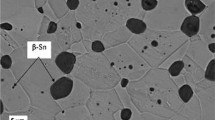Abstract
Tin pest is the result of an allotropic transformation of tin from its β phase to its α phase at temperatures below 13 °C. This transformation is accompanied by a change in density from 7.31 to 5.77 g/cm3. The resulting expansion usually results in degradation of the affected part, as the α phase material is mechanically weak and over time becomes little more than a gray powder. The tin pest effect is cumulative unless the sample in question is exposed to temperatures above 70 °C or so, where some reversion back to white tin has been observed. However, by this point a tin sample’s physical integrity may have been destroyed by the partial β to α transformation. The transformation to α tin is inhibited strongly by soluble alloying elements such as bismuth and antimony at concentrations of about 0.5%, or lead at concentrations of about 5%. Hence, tin pest is generally observed only in quite pure tin. However, nearly pure tin alloys may become common. For example, the advent of the European Union’s RoHS law, which essentially eliminates lead from solder, has spawned lead-free alloys that can be almost pure tin and may be at risk of tin pest. This risk has caused some concern over the long-term stability of emergent, lead-free solders during low temperature service. This overview article is written in light of this concern.







Similar content being viewed by others
References
Harris, P.: Tin pest: a review of the current state of knowledge. Unpublished, private communication, ITRI (2000)
Le Couteur, P., Burreson, J.: Napoleon’s Buttons: How 17 Molecules Changed History. Tarcher, New York (2004)
Chiavari, C., et al.: Deterioration of tin-rich organ pipes. J. Mater. Sci. 41, 1819–1826 (2006)
Taylor, A.: An Introduction to X-Ray Metallography. Chapman and Hall, London (1945)
Homer, C.E., Watkins, H.C.: Transformation of tin at low temperatures. Met. Ind. 60(22), 364–366 (1942)
Havia, E.: Private communication, December (2009)
Burns, N.D.: A tin pest failure. J. Fail. Anal. Prev. 9, 461–465 (2009)
MacIntosh, R.M.: Tin in cold service. In: Tin and its Uses, vol. 6, pp. 72. Tin Research Institute Inc., USA (1966)
Rogers, R.R., Fydell, J.F.: Factors affecting the transformation to grey tin at low temperatures. J. Electrochem. Soc. 100(9), 383–387 (1953)
Vnuk, F.: The kinetics of β to α transformation of tin. In: Metal Congress, pp. 176–185 (1975)
Raynor, G.V., Smith, R.W.: Proc. R. Soc. 244A, 101–109 (1958)
Matvienko, A.A., Sidelnikov, A.A.: The influence of relaxation of stresses occurring during the [beta] → [alpha] transformation of tin on the kinetics of the transformation. J. Alloys Compd. 252, 172–178 (1997)
Plumbridge, W.J.: Tin pest issues in lead-free electronic solders. J. Mater. Sci. Mater. Electron. 18, 307–318 (2007)
Joo, Y.J., Takemoto, T.: Mater. Lett. 56(5), 793–796 (2002)
Plumbridge, W.J.: J. Electr. Mater. 37(2), 218–223 (2007)
Liu, W., Lee, N.-C.: Novel SACX Solders with Superior Drop Test Performance, SMTAI, Chicago, IL, September (2006)
Acknowledgments
I am appreciative of all of the recent work of Professor Bill Plumbridge. He is been a leader in tin pest research in this era. I am also grateful for the help of the Tin Institute (ITRI), most notably from Dr. Paul Harris.
Author information
Authors and Affiliations
Corresponding author
Rights and permissions
About this article
Cite this article
Lasky, R.C. Tin Pest: Elusive Threat in Lead-Free Soldering?. J Fail. Anal. and Preven. 10, 437–443 (2010). https://doi.org/10.1007/s11668-010-9391-2
Received:
Published:
Issue Date:
DOI: https://doi.org/10.1007/s11668-010-9391-2




